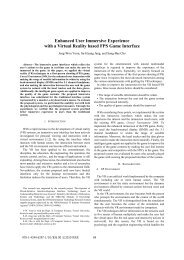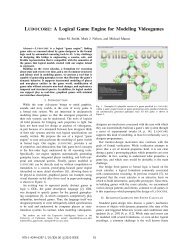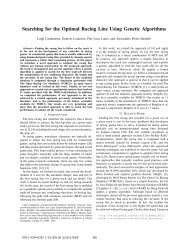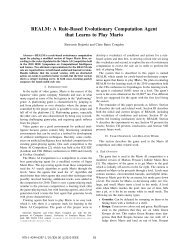an article in Science - Center for Computer Games Research
an article in Science - Center for Computer Games Research
an article in Science - Center for Computer Games Research
You also want an ePaper? Increase the reach of your titles
YUMPU automatically turns print PDFs into web optimized ePapers that Google loves.
CREDITS (TOP TO BOTTOM): RESCUESIM/WWW.VSTEP.NL; COURTESY JORGE MUÑOZ AND RAÚL ARRABALES MORENO<br />
The output was <strong>an</strong> eight-dimensional<br />
“shadow” of the WoW data, projected as a<br />
simple 2D plot, that evolves over the course<br />
of the 4-year period of the study (see figure,<br />
p. 30). For the most part, says Thurau, the<br />
results confirm m<strong>an</strong>y researchers’ hunches<br />
about the social behavior of WoW players.<br />
Only a small fraction of guilds are active, those<br />
run by highly org<strong>an</strong>ized, ambitious groups of<br />
players. In spite of the stagger<strong>in</strong>g fraction of<br />
their lives spent <strong>in</strong> the game, most players are<br />
“casual rather th<strong>an</strong> hardcore,” he says.<br />
Game-m<strong>in</strong><strong>in</strong>g isn’t just <strong>for</strong> multiplayer<br />
games. A team led by Georgios Y<strong>an</strong>nakakis,<br />
a computer scientist at the IT University of<br />
Copenhagen, described player behavior <strong>in</strong><br />
Tomb Raider: Underworld, a s<strong>in</strong>gle-person<br />
game <strong>in</strong> which a gun-tot<strong>in</strong>g female archaeologist<br />
steals artifacts from ru<strong>in</strong>s. They <strong>an</strong>alyzed<br />
data from 10,000 players on the Xbox Live<br />
network, cover<strong>in</strong>g 35 different variables such<br />
as the use of weapons, the rate of progress,<br />
<strong>an</strong>d whether it was tigers, traps, or other hazards<br />
that killed them. Their aim was to tra<strong>in</strong><br />
a computer to predict the level at which <strong>an</strong>y<br />
given player will eventually quit the game out<br />
of frustration—one of the hopes of the game<br />
<strong>in</strong>dustry is to create “personalized” games that<br />
adapt to each player’s abilities <strong>an</strong>d <strong>in</strong>terests.<br />
The computer wasn’t perfect at <strong>for</strong>etell<strong>in</strong>g<br />
the players’ fates, but it was far better<br />
th<strong>an</strong> r<strong>an</strong>dom. Just by observ<strong>in</strong>g how people<br />
played the first two levels of the game, it could<br />
predict with 77% accuracy where they would<br />
give up. Much of that prediction power<br />
came from count<strong>in</strong>g the number of seconds<br />
players took to navigate a s<strong>in</strong>gle obstacle, the<br />
jellyfish-filled “flush tunnel.” Y<strong>an</strong>nakakis says<br />
the accuracy should improve as he tracks more<br />
players <strong>for</strong> the tra<strong>in</strong><strong>in</strong>g, as well as obta<strong>in</strong><strong>in</strong>g<br />
“f<strong>in</strong>er gr<strong>an</strong>ularity” <strong>in</strong> the data, such as players’<br />
exact routes of movement.<br />
–J.B.<br />
Smarts <strong>for</strong> Serious <strong>Games</strong><br />
You are a firefighter. As a blaze spreads across<br />
the factory, a pa<strong>in</strong>t c<strong>an</strong>ister goes off like a<br />
bomb. There are still p<strong>an</strong>icked workers to be<br />
cleared. And to make matters worse, one of<br />
your crew is <strong>in</strong>jured. How do you proceed?<br />
Don’t worry, it’s just a game. But play<strong>in</strong>g it<br />
could save lives. <strong>Games</strong> with ulterior motives<br />
such as teach<strong>in</strong>g or tra<strong>in</strong><strong>in</strong>g people—known<br />
among researchers as “serious games”—are<br />
on the rise, provid<strong>in</strong>g a cheap <strong>an</strong>d safe supplement<br />
to on-the-job tra<strong>in</strong><strong>in</strong>g. But serious games<br />
face “big problems” because of their simple<br />
programm<strong>in</strong>g, says Joost Westra, a computer<br />
scientist at Utrecht University <strong>in</strong> the Netherl<strong>an</strong>ds.<br />
In a real fire, there c<strong>an</strong> be hundreds of<br />
people mak<strong>in</strong>g unpredictable decisions all<br />
around you. Yet the nonplayer characters<br />
(NPCs) <strong>in</strong> the games usually follow tightly<br />
scripted behaviors, so unless you play<br />
exactly as the programmer expects, NPCs<br />
behave like confused robots. Another flaw<br />
<strong>in</strong> serious games is that they use “fixed<br />
scenarios or simple rules to determ<strong>in</strong>e the<br />
course of the game,” says Westra. “Expert<br />
users c<strong>an</strong> quickly estimate how the game<br />
will react to their actions” but still must<br />
play through the easy levels to reach their<br />
proper level. The result, he says, is “disengagement,<br />
boredom, <strong>an</strong>d possibly quitt<strong>in</strong>g<br />
the game be<strong>for</strong>e that level is reached.”<br />
To fix these problems, Westra created a<br />
new architecture <strong>for</strong> serious games that uses<br />
artificial-<strong>in</strong>telligence (AI) techniques similar<br />
to those <strong>in</strong> some of the latest video games. He<br />
focused on a game called RescueSim, a serious<br />
game <strong>for</strong> firefighters. Rather th<strong>an</strong> follow<strong>in</strong>g<br />
scripts, Westra’s code turns each NPC <strong>in</strong>to<br />
<strong>an</strong> autonomous agent with its own nu<strong>an</strong>ced<br />
goals, respond<strong>in</strong>g to events as they happen.<br />
An NPC firefighter, <strong>for</strong> example, will have the<br />
NEWSFOCUS<br />
Trial by fire. A so-called serious game tra<strong>in</strong>s rescue<br />
workers at a factory blaze.<br />
goal of ext<strong>in</strong>guish<strong>in</strong>g a fire but c<strong>an</strong> switch to<br />
help<strong>in</strong>g <strong>an</strong> <strong>in</strong>jured comrade if no one else is<br />
near. An NPC’s awareness of what the game’s<br />
player <strong>an</strong>d the other agents are do<strong>in</strong>g is crucial,<br />
Westra says, because firefight<strong>in</strong>g requires<br />
teamwork. One firefighter must turn on the<br />
pump while <strong>an</strong>other keeps doors closed to<br />
prevent drafts that feed the fire; yet <strong>an</strong>other<br />
must operate the hose.<br />
In early test<strong>in</strong>g of the system, the AI<br />
architecture shows promise. Not only does it<br />
make NPCs act reasonably, Westra says, but<br />
the entire game c<strong>an</strong> also now adapt to different<br />
users. Beg<strong>in</strong>ners take on only simple jobs<br />
while NPCs take care of the rest; expert players<br />
must learn to comm<strong>an</strong>d a crew <strong>in</strong> complex<br />
situations. “A game needs to be built with this<br />
architecture from the beg<strong>in</strong>n<strong>in</strong>g,” says Westra,<br />
who pl<strong>an</strong>s to design a “bush fire team tra<strong>in</strong><strong>in</strong>g”<br />
game with collaborators <strong>in</strong> Turkey.<br />
“This is the future of serious games,” says<br />
Kyong J<strong>in</strong> Shim, a computer scientist at the<br />
University of M<strong>in</strong>nesota, Tw<strong>in</strong> Cities, who is<br />
develop<strong>in</strong>g such a system <strong>for</strong> tra<strong>in</strong><strong>in</strong>g U.S.<br />
soldiers. “We need smarter agents <strong>an</strong>d <strong>in</strong>game<br />
characters.”<br />
–J.B.<br />
Downloaded from www.sciencemag.org on September 30, 2010<br />
The hum<strong>an</strong>s are dead! A Sp<strong>an</strong>ish<br />
team (right) won this year’s 2K Bot-<br />
Prize.<br />
skills, like attention <strong>an</strong>d learn<strong>in</strong>g,” says Raúl Arrabales Moreno, a computer<br />
scientist at the University Carlos III of Madrid. The bot has a set of<br />
<strong>in</strong>nate behaviors that are regulated by a higher control system, similar<br />
to the role of a conscious m<strong>in</strong>d. It was <strong>in</strong>correctly identified as hum<strong>an</strong><br />
by the judges 32% of the time. By comparison, one hum<strong>an</strong> player was<br />
<strong>in</strong>correctly identified as a mach<strong>in</strong>e 35% of the time. “There is only a<br />
slender gap between the hum<strong>an</strong>s <strong>an</strong>d bots now,” says H<strong>in</strong>gston.<br />
“There has been signific<strong>an</strong>t progress s<strong>in</strong>ce the 2009 competition,”<br />
says Simon Lucas, a computer scientist at the University of Essex <strong>in</strong> the<br />
United K<strong>in</strong>gdom <strong>an</strong>d one of the hum<strong>an</strong> players <strong>in</strong> the contest. Besides<br />
creat<strong>in</strong>g more engag<strong>in</strong>g computer-controlled opponents <strong>for</strong> massmarket<br />
video games, the goal is to create better AI agents <strong>for</strong> “serious<br />
games” that simulate natural disasters <strong>an</strong>d other complex problems<br />
(see above). Lucas predicts that a bot will be fully <strong>in</strong>dist<strong>in</strong>guishable<br />
from hum<strong>an</strong> players “with<strong>in</strong> the next 2 years.”<br />
–JOHN BOHANNON<br />
www.sciencemag.org SCIENCE VOL 330 1 OCTOBER 2010 31<br />
Published by AAAS







